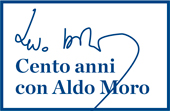DC had been defeated in the divorce referendum; terrorism was growing worse (bombing in Brescia and on the train Italicus, spring-summer 1974); inflation was high. This was the situation as Moro was, for the fourth time, appointed President of the Council, and formed a two-party government DC-PRI (Ugo La Malfa was appointed Vice-president of the Council) with the support of PSI and PSDI, as close to centre-left as was possible in those years (November 1974 – January 1976). As far as trade unions were concerned, the match regarded a bargain between Unions’ moderated attitude against fiscal policy, but this worked only partially because of revived inflation and economic crisis. On the contrary, as far as politics were concerned, the Communist opposition started a close dialogue with the government as regarded economic policy and reforms. This alarmed Ford’s administration, and relations between Moro and the US Secretary of State, Henry Kissinger, were somehow affected.
Administrative elections (June 1975) brought a strong success for PCI: the party gained 33.4 % of the vote and got very near a falling DC (35.3%). In late 1975 PSI withdrew from the vote of confidence with the government. Moro was at the head of his fifth executive, a single-party, DC government (February-June 1976), which was bound to the second anticipated end of the legislature.
Dimissioni del quinto governo Moro, Roma, 30 aprile 1976
